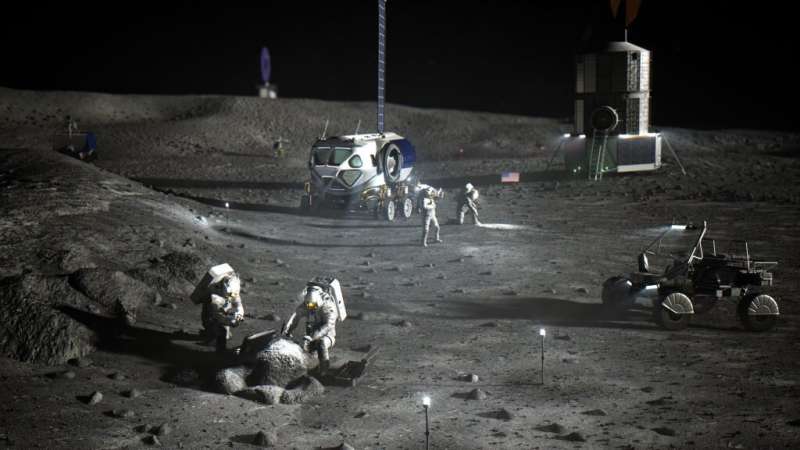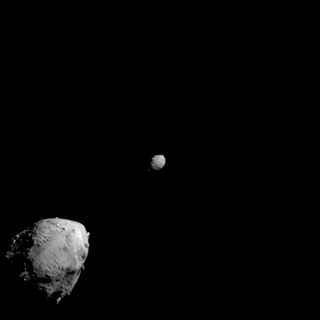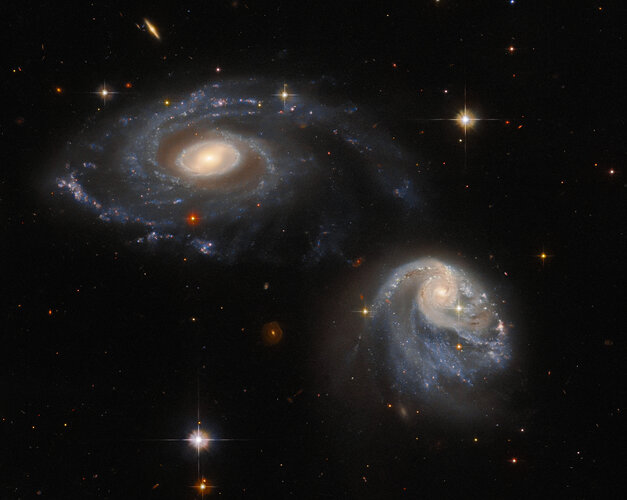
Copernical Team
Sunday, 09 October 2022 10:15
SpaceX launches two Intelsat Galaxy satellites after aborted mission
Washington DC (UPI) Oct 8, 2021
 SpaceX on Saturday launched two Intelsat satellites into Earth orbit after the mission was aborted Friday night.
The Galaxy 33 and Galaxy 34 communication satellites were launched by a SpaceX Falcon 9 rocket at 7:05 p.m. EDT by SpaceX on behalf of the company Intelsat from Space Launch Complex 40 at Cape Canaveral Space Force Station in Florida.
The Falcon 9's first stage boo
SpaceX on Saturday launched two Intelsat satellites into Earth orbit after the mission was aborted Friday night.
The Galaxy 33 and Galaxy 34 communication satellites were launched by a SpaceX Falcon 9 rocket at 7:05 p.m. EDT by SpaceX on behalf of the company Intelsat from Space Launch Complex 40 at Cape Canaveral Space Force Station in Florida.
The Falcon 9's first stage boo
 SpaceX on Saturday launched two Intelsat satellites into Earth orbit after the mission was aborted Friday night.
The Galaxy 33 and Galaxy 34 communication satellites were launched by a SpaceX Falcon 9 rocket at 7:05 p.m. EDT by SpaceX on behalf of the company Intelsat from Space Launch Complex 40 at Cape Canaveral Space Force Station in Florida.
The Falcon 9's first stage boo
SpaceX on Saturday launched two Intelsat satellites into Earth orbit after the mission was aborted Friday night.
The Galaxy 33 and Galaxy 34 communication satellites were launched by a SpaceX Falcon 9 rocket at 7:05 p.m. EDT by SpaceX on behalf of the company Intelsat from Space Launch Complex 40 at Cape Canaveral Space Force Station in Florida.
The Falcon 9's first stage boo
Published in
News
Tagged under
Saturday, 08 October 2022 11:17
SpaceX aborts launch of two communication satellites into orbit
Washington DC (UPI) Oct 7, 2021
 The launch of two SpaceX communications satellites from Cape Canaveral Space Force Station on Friday was aborted again and is now scheduled for Saturday.
The Galaxy 33 and 34 satellites had been scheduled to lift off at 7:06 p.m. and to help the telecommunications company Intelsat maintain service in North America. However, the launch was bumped back a day to Saturday night.
Spac
The launch of two SpaceX communications satellites from Cape Canaveral Space Force Station on Friday was aborted again and is now scheduled for Saturday.
The Galaxy 33 and 34 satellites had been scheduled to lift off at 7:06 p.m. and to help the telecommunications company Intelsat maintain service in North America. However, the launch was bumped back a day to Saturday night.
Spac
 The launch of two SpaceX communications satellites from Cape Canaveral Space Force Station on Friday was aborted again and is now scheduled for Saturday.
The Galaxy 33 and 34 satellites had been scheduled to lift off at 7:06 p.m. and to help the telecommunications company Intelsat maintain service in North America. However, the launch was bumped back a day to Saturday night.
Spac
The launch of two SpaceX communications satellites from Cape Canaveral Space Force Station on Friday was aborted again and is now scheduled for Saturday.
The Galaxy 33 and 34 satellites had been scheduled to lift off at 7:06 p.m. and to help the telecommunications company Intelsat maintain service in North America. However, the launch was bumped back a day to Saturday night.
Spac
Published in
News
Tagged under
Friday, 07 October 2022 15:38
NASA had been designing lunar bases for decades before Armstrong first set foot on the moon

It's only natural to look at the moon and wonder what it would be like to live there. Thanks to Buzz Aldrin who landed there in 1969, we know it's a magnificent desolation. Even before the Apollo missions science fiction writers and scientists knew how desolate the place was. But, as far back as the late 19th century, they also saw it as a natural outpost. So did NASA, the former Soviet Union, and their respective militaries. And, that led to people on both sides drawing up elaborate plans for moon bases.
Published in
News
Tagged under
Friday, 07 October 2022 18:34
NASA to Provide Update on DART, World’s First Planetary Defense Test
 NASA will host a media briefing at 2 p.m. EDT, Tuesday, Oct. 11, to discuss the agency’s Double Asteroid Redirection Test (DART) mission and its intentional collision with its target asteroid, Dimorphos.
NASA will host a media briefing at 2 p.m. EDT, Tuesday, Oct. 11, to discuss the agency’s Double Asteroid Redirection Test (DART) mission and its intentional collision with its target asteroid, Dimorphos.
Published in
News
Tagged under
Friday, 07 October 2022 12:05
Week in images: 03-07 October 2022

Week in images: 03-07 October 2022
Discover our week through the lens
Published in
News
Tagged under
Friday, 07 October 2022 10:19
NASA's upgraded Mobile Mission Control Center to analyze Advanced Air Mobility flight tests
Edwards AFB CA (SPX) Oct 06, 2022
 NASA recently unveiled a series of upgrades to its Mobile Operations Facility (MOF), a specially outfitted mission control center on wheels housed at NASA's Armstrong Flight Research Center in Edwards, California. NASA's Advanced Air Mobility (AAM) National Campaign will use the MOF to test systems required to integrate air taxis, cargo delivery, and other AAM concepts into the National Airspace
NASA recently unveiled a series of upgrades to its Mobile Operations Facility (MOF), a specially outfitted mission control center on wheels housed at NASA's Armstrong Flight Research Center in Edwards, California. NASA's Advanced Air Mobility (AAM) National Campaign will use the MOF to test systems required to integrate air taxis, cargo delivery, and other AAM concepts into the National Airspace
 NASA recently unveiled a series of upgrades to its Mobile Operations Facility (MOF), a specially outfitted mission control center on wheels housed at NASA's Armstrong Flight Research Center in Edwards, California. NASA's Advanced Air Mobility (AAM) National Campaign will use the MOF to test systems required to integrate air taxis, cargo delivery, and other AAM concepts into the National Airspace
NASA recently unveiled a series of upgrades to its Mobile Operations Facility (MOF), a specially outfitted mission control center on wheels housed at NASA's Armstrong Flight Research Center in Edwards, California. NASA's Advanced Air Mobility (AAM) National Campaign will use the MOF to test systems required to integrate air taxis, cargo delivery, and other AAM concepts into the National Airspace
Published in
News
Tagged under
Friday, 07 October 2022 10:19
Viasat to sell its Link 16 Tactical Data Links business to L3Harris Technologies
Carlsbad CA (SPX) Oct 06, 2022
 Viasat Inc. (NASDAQ: VSAT), a global leader in satellite communications, reports it has entered into a definitive agreement to sell its Link 16 Tactical Data Links (TDL) business to L3Harris Technologies for $1.96 billion, subject to customary transaction adjustments in accordance with the agreement. The sale is expected to result in cash proceeds to Viasat of approximately $1.8 billion net afte
Viasat Inc. (NASDAQ: VSAT), a global leader in satellite communications, reports it has entered into a definitive agreement to sell its Link 16 Tactical Data Links (TDL) business to L3Harris Technologies for $1.96 billion, subject to customary transaction adjustments in accordance with the agreement. The sale is expected to result in cash proceeds to Viasat of approximately $1.8 billion net afte
 Viasat Inc. (NASDAQ: VSAT), a global leader in satellite communications, reports it has entered into a definitive agreement to sell its Link 16 Tactical Data Links (TDL) business to L3Harris Technologies for $1.96 billion, subject to customary transaction adjustments in accordance with the agreement. The sale is expected to result in cash proceeds to Viasat of approximately $1.8 billion net afte
Viasat Inc. (NASDAQ: VSAT), a global leader in satellite communications, reports it has entered into a definitive agreement to sell its Link 16 Tactical Data Links (TDL) business to L3Harris Technologies for $1.96 billion, subject to customary transaction adjustments in accordance with the agreement. The sale is expected to result in cash proceeds to Viasat of approximately $1.8 billion net afte
Published in
News
Tagged under
Friday, 07 October 2022 10:19
Millennium Space Systems awarded Space Safari effort
Los Angeles CA (SPX) Oct 06, 2022
 Millennium is delivering the satellite for VICTUS NOX, a Tactically Responsive Space mission led by the Space Safari Program Office within Space Systems Command.
"We're extremely excited to partner with Millennium Space Systems on our upcoming VICTUS NOX mission. Their innovative team is helping lead the way for Tactically Responsive Space, ensuring the U.S. has the ability to immediately
Millennium is delivering the satellite for VICTUS NOX, a Tactically Responsive Space mission led by the Space Safari Program Office within Space Systems Command.
"We're extremely excited to partner with Millennium Space Systems on our upcoming VICTUS NOX mission. Their innovative team is helping lead the way for Tactically Responsive Space, ensuring the U.S. has the ability to immediately
 Millennium is delivering the satellite for VICTUS NOX, a Tactically Responsive Space mission led by the Space Safari Program Office within Space Systems Command.
"We're extremely excited to partner with Millennium Space Systems on our upcoming VICTUS NOX mission. Their innovative team is helping lead the way for Tactically Responsive Space, ensuring the U.S. has the ability to immediately
Millennium is delivering the satellite for VICTUS NOX, a Tactically Responsive Space mission led by the Space Safari Program Office within Space Systems Command.
"We're extremely excited to partner with Millennium Space Systems on our upcoming VICTUS NOX mission. Their innovative team is helping lead the way for Tactically Responsive Space, ensuring the U.S. has the ability to immediately
Published in
News
Tagged under
Friday, 07 October 2022 10:19
Sidus Space announces slew of new orders for Space and Defense sales
Cape Canaveral FL (SPX) Oct 06, 2022
 Sidus Space, Inc. (NASDAQ:SIDU), a Space-as-a-Service satellite company focused on commercial satellite design, manufacture, launch, and data collection is pleased to announce that, in the quarter ended September 30, 2022, it has received a combined total of over $1.9 million in new purchase orders for space and defense hardware and services supporting multiple customers.
"Space and defens
Sidus Space, Inc. (NASDAQ:SIDU), a Space-as-a-Service satellite company focused on commercial satellite design, manufacture, launch, and data collection is pleased to announce that, in the quarter ended September 30, 2022, it has received a combined total of over $1.9 million in new purchase orders for space and defense hardware and services supporting multiple customers.
"Space and defens
 Sidus Space, Inc. (NASDAQ:SIDU), a Space-as-a-Service satellite company focused on commercial satellite design, manufacture, launch, and data collection is pleased to announce that, in the quarter ended September 30, 2022, it has received a combined total of over $1.9 million in new purchase orders for space and defense hardware and services supporting multiple customers.
"Space and defens
Sidus Space, Inc. (NASDAQ:SIDU), a Space-as-a-Service satellite company focused on commercial satellite design, manufacture, launch, and data collection is pleased to announce that, in the quarter ended September 30, 2022, it has received a combined total of over $1.9 million in new purchase orders for space and defense hardware and services supporting multiple customers.
"Space and defens
Published in
News
Tagged under
Friday, 07 October 2022 10:19
US Space Surveillance Telescope in Australia achieves initial operational capability
Peterson SFB CO (SPX) Oct 06, 2022
 The Australian Department of Defence and the U.S. Space Force declared initial operational capability for the Space Surveillance Telescope at Naval Communication Station Harold E. Holt, Australia, Sept. 30, 2022.
The SST is a military telescope that provides ground-based, broad-area search, detection and tracking of faint objects in deep space to help predict and avoid potential collisions
The Australian Department of Defence and the U.S. Space Force declared initial operational capability for the Space Surveillance Telescope at Naval Communication Station Harold E. Holt, Australia, Sept. 30, 2022.
The SST is a military telescope that provides ground-based, broad-area search, detection and tracking of faint objects in deep space to help predict and avoid potential collisions
 The Australian Department of Defence and the U.S. Space Force declared initial operational capability for the Space Surveillance Telescope at Naval Communication Station Harold E. Holt, Australia, Sept. 30, 2022.
The SST is a military telescope that provides ground-based, broad-area search, detection and tracking of faint objects in deep space to help predict and avoid potential collisions
The Australian Department of Defence and the U.S. Space Force declared initial operational capability for the Space Surveillance Telescope at Naval Communication Station Harold E. Holt, Australia, Sept. 30, 2022.
The SST is a military telescope that provides ground-based, broad-area search, detection and tracking of faint objects in deep space to help predict and avoid potential collisions
Published in
News
Tagged under

